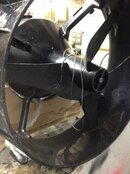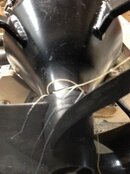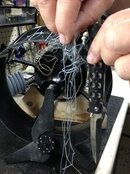What are you talking about? Before you die, you have to live out half of your life. Then you live half of the rest of your life, then half of the rest, etc. ad infinitum.Not really. One heck of a lot of air, yes, but not infinite. Death from old age will kick in at some point.
You are using an out of date browser. It may not display this or other websites correctly.
You should upgrade or use an alternative browser.
You should upgrade or use an alternative browser.
Optimal Pony Bottle Size for Failure at 100ft?
- Thread starter chrisjur
- Start date
Please register or login
Welcome to ScubaBoard, the world's largest scuba diving community. Registration is not required to read the forums, but we encourage you to join. Joining has its benefits and enables you to participate in the discussions.
Benefits of registering include
- Ability to post and comment on topics and discussions.
- A Free photo gallery to share your dive photos with the world.
- You can make this box go away
SpaceX Aquanaut
Banned
Thank you @rsingler !Will let me play mediator here...
@SpaceX Aquanaut, by his profile, is a very experienced technical diver. So I think some of the criticisms here may be a little over the top.
I found myself in similar circumstances a decade ago, where I took a position and felt the need to defend it.
If one accepts the possibility that SpaceX dives to significant depth off surge'y oil platforms, then SMB's that might get entangled might not be a good choice. But similarly, that same surge might want to keep someone a bit further away from the legs to avoid getting barnacle rash. So visual indicators may be lacking, especially at night.
My own conclusion is that the technique described is a bit of Normalization of Deviance, where a solution that seemed logical in the circumstances, and works most of the time, gradually deviates further and further from "standard" practice.
I think it ran up against a wall when the constraints of a limited pony supply were imposed. Things were exacerbated by an erroneous computation that ended up being 10 fpm ascent rate instead of 30 fpm.
If his average is 30fpm on a no-stop dive, then I have no argument with it, and an AL19 or AL40 will work. But me, I have no problem with maintaining a fairly stable ascent rate with occasional glances at my computer.
Tomaytoe, tomahto.
BTW, there is nothing erroneous about the 10fpm/3mpm -just easier to do the "volume math-consumption" for starters, simply multiplying by 1min per every 0.3 ATA level stop on the ascent (versus 0.3min multiplication for 30fpm/9mpm).
So to recite -and given that the OP has an AL40 which he calculated for an ascent profile from 30m/100' -
should he feel compelled to go down to 39m/130' for whatever reason with that AL40 as pony backup:
28 litres/min SCR (roughly same as 1cuft/min stressed volume SAC rate in US Imperial units), with 39meters ( 4.9ATA) depth NDL with one minute stops every 3 meters to surface:
4.9 x 28 x 1 = 137.2
4.6 x 28 x 1 = 128.8
4.3 x 28 x 1 = 120.4
4.0 x 28 x 1 = 112
3.7 x 28 x 1 = 103.6
3.4 x 28 x 1 = 95.2
3.1 x 28 x 1 = 86.8
2.8 x 28 x 1 = 78.4
2.5 x 28 x 1 = 70
2.2 x 28 x 1 = 61.6
1.9 x 28 x 1 = 53.2
1.6 x 28 x 1 = 44.8
1.3 x 28 x 1 = 36.4
1.0 x 28 x 1 = 28
Sum Total: 1156.4 litres gas needed for one person to ascend to surface from 39m depth for an emergency contingency with a fairly reasonable & controlled ascent rate.
A 5.5L cylinder (AL40 "pony bottle") filled to 200 bar pressure supplies 1100 litres.
(Note: this is for worst case contingency option only, with no decompression obligation or barely any remaining air left for a "Safety Stop")
If he wants to ascend at the maximum recommended 30fpm/9mpm, of course he will come up with more remaining air in his AL40 (roughly 50-70% of full depending on what Safety Stop time he wants to perform).
Again, there's nothing wrong (or "normalizingly deviant") about pausing 10 seconds at each delta 0.3 ATA up from max 4.9 ATA pressure depth, and then 10 seconds ascent & move to the next level stop. 30 feet-per-minute (or 9mpm) is 30 feet-per-60 seconds, same as 10 feet-per-20 seconds -->or just easier to perform in practice: Hold for 10 seconds and move for 10 seconds every 10 feet (or every 3 meters). Else if you want to try and do it continuously, that translates to 1 foot up every two seconds. . .
Lastly, the above table again in US Imperial Units, using 1 cuft/min volume SAC rate, and 1 minute stops:
4.9 x 1 x 1 = 4.9
4.6 x 1 x 1 = 4.6
4.3 x 1 x 1 = 4.3
4.0 x 1 x 1 = 4
3.7 x 1 x 1 = 3.7
3.4 x 1 x 1 = 3.4
3.1 x 1 x 1 = 3.1
2.8 x 1 x 1 = 2.8
2.5 x 1 x 1 = 2.5
2.2 x 1 x 1 = 2.2
1.9 x 1 x 1 = 1.9
1.6 x 1 x 1 = 1.6
1.3 x 1 x 1 = 1.3
1.0 x 1 x 1 = 1.0
Sum Total: 41.3 cubic feet of Air
An AL40. . .
Dude! Except...you run out of gas!BTW, there is nothing erroneous about the 10fpm/3mpm -just easier to do the "volume math-consumption"
And, me? There's no way I'm stopping an extra minute at each of 90', 80' and 70' when I'm making a contingency ascent. Even if it IS surge'y. Even if there are upwellings. It's plain bad nitrogen management. And the problem you cite doesn't exist in open ocean at 90 feet. Maybe on a monstrous wall dive. But not next to an oil rig.
I'll accept your specific concern for runaway ascents. But those are only at 30' and up. Gas expansion deeper is much smaller, and there is no reason to make these stops at those depths. You're loading nitrogen; you're not expanding enough to risk a runaway ascent, and you're running out of gas.
I think you're kind of working your way out on a limb defending this practice. I feel badly that you felt you had to respond.
SpaceX Aquanaut
Banned
If the OP were doing these dives/profiles -two or three each day- for three consecutive days or more, then that's where the Slow Tissues begin to take their N2 Load Toll (i.e Deep Stops finally becomes physio-pathological presenting to DCS type I symptoms -limbs & joint spaces. You have to do extra-long O2 deco to wash-out out these tissues by the second day).Dude! Except...you run out of gas!
And, me? There's no way I'm stopping an extra minute at each of 90', 80' and 70' when I'm making a contingency ascent. Even if it IS surge'y. Even if there are upwellings. It's plain bad nitrogen management. And the problem you cite doesn't exist in open ocean at 90 feet. Maybe on a monstrous wall dive. But not next to an oil rig.
I'll accept your specific concern for runaway ascents. But those are only at 30' and up. Gas expansion deeper is much smaller, and there is no reason to make these stops at those depths. You're loading nitrogen; you're not expanding enough to risk a runaway ascent, and you're running out of gas.
I think you're kind of working your way out on a limb defending this practice. I feel badly that you felt you had to respond.
And the Oil Rigs off SoCal, you gotta be cognizant and hyper-aware of monofilament in the support structure & drill tubes at all depths from 100msw to the upwelling surge at a 6m O2 deco stop:
My DPV on 18 Nov 2018 (Sierra X-Scooter still brought me back to the surface despite being fouled in fishing line):
Attachments
SpaceX Aquanaut
Banned
Obviously. Don't need a spreadsheet to tell you that!Dude! Except...you run out of gas!
<snip>
- Messages
- 14,194
- Reaction score
- 11,459
- Location
- Port Orchard, Washington State
- # of dives
- 1000 - 2499
This is a good way to run out of gas twice and drownThank you @rsingler !
BTW, there is nothing erroneous about the 10fpm/3mpm -just easier to do the "volume math-consumption" for starters, simply multiplying by 1min per every 0.3 ATA level stop on the ascent (versus 0.3min multiplication for 30fpm/9mpm).
So to recite -and given that the OP has an AL40 which he calculated for an ascent profile from 30m/100' -
should he feel compelled to go down to 39m/130' for whatever reason with that AL40 as pony backup:
28 litres/min SCR (roughly same as 1cuft/min stressed volume SAC rate in US Imperial units), with 39meters ( 4.9ATA) depth NDL with one minute stops every 3 meters to surface:
4.9 x 28 x 1 = 137.2
4.6 x 28 x 1 = 128.8
4.3 x 28 x 1 = 120.4
4.0 x 28 x 1 = 112
3.7 x 28 x 1 = 103.6
3.4 x 28 x 1 = 95.2
3.1 x 28 x 1 = 86.8
2.8 x 28 x 1 = 78.4
2.5 x 28 x 1 = 70
2.2 x 28 x 1 = 61.6
1.9 x 28 x 1 = 53.2
1.6 x 28 x 1 = 44.8
1.3 x 28 x 1 = 36.4
1.0 x 28 x 1 = 28
Sum Total: 1156.4 litres gas needed for one person to ascend to surface from 39m depth for an emergency contingency with a fairly reasonable & controlled ascent rate.
A 5.5L cylinder (AL40 "pony bottle") filled to 200 bar pressure supplies 1100 litres.
(Note: this is for worst case contingency option only, with no decompression obligation or barely any remaining air left for a "Safety Stop")
If he wants to ascend at the maximum recommended 30fpm/9mpm, of course he will come up with more remaining air in his AL40 (roughly 50-70% of full depending on what Safety Stop time he wants to perform).
Again, there's nothing wrong (or "normalizingly deviant") about pausing 10 seconds at each delta 0.3 ATA up from max 4.9 ATA pressure depth, and then 10 seconds ascent & move to the next level stop. 30 feet-per-minute (or 9mpm) is 30 feet-per-60 seconds, same as 10 feet-per-20 seconds -->or just easier to perform in practice: Hold for 10 seconds and move for 10 seconds every 10 feet (or every 3 meters). Else if you want to try and do it continuously, that translates to 1 foot up every two seconds. . .
Lastly, the above table again in US Imperial Units, using 1 cuft/min volume SAC rate, and 1 minute stops:
4.9 x 1 x 1 = 4.9
4.6 x 1 x 1 = 4.6
4.3 x 1 x 1 = 4.3
4.0 x 1 x 1 = 4
3.7 x 1 x 1 = 3.7
3.4 x 1 x 1 = 3.4
3.1 x 1 x 1 = 3.1
2.8 x 1 x 1 = 2.8
2.5 x 1 x 1 = 2.5
2.2 x 1 x 1 = 2.2
1.9 x 1 x 1 = 1.9
1.6 x 1 x 1 = 1.6
1.3 x 1 x 1 = 1.3
1.0 x 1 x 1 = 1.0
Sum Total: 41.3 cubic feet of Air
An AL40. . .
SpaceX Aquanaut
Banned
Which is why the OP should not be tempted to go down to 39m/130' with an AL40 pony bottle of Air. . .This is a good way to run out of gas twice and drown
If you get hung up for whatever reason (e.g. fishing line/gill net entanglement) coming up on only an AL40, then you're 'effed.
I think you’re judging the pressure change, up or down. Divers doing a lot of saw tooth dives get very good at it.With experience, I have come to recognize my ascent rate, whether that uses bubble rise, I'm not really sure, I think not. This does not seem to be dependent on landmarks. My usual, leisurely, horizontal ascent rate is almost always about 20 ft/min. 30 ft/min seems fast. 60 ft/min seems very, very fast. I never look at my ascent rate and only check my depth when getting close to the safety stop, or a deco stop. It's interesting watching other divers with their eyes fixed on their computers, they generally end up somewhere near my depth. If I was to need to use my pony, I'm pretty sure I could do it with a reasonable ascent.
View attachment 879217
Since you're still pushing the issue, I'll keep replying...Which is why the OP should not be tempted to go down to 39m/130' with an AL40 pony bottle of Air. . .
If you get hung up for whatever reason (e.g. fishing line/gill net entanglement) coming up on only an AL40, then you're 'effed.
Your statement above now presumes THREE failures: gas supply failure, no buddy, and now entanglement.
I don't plan for three failures. An AL40 is just fine for a 130' NDL dive. It's redundant gas. It's plenty for a standard ascent and 15 minutes of deco. If you're indeed NDL diving, then it's even enough for a 60fpm ascent to 60 feet, a standard 30 fpm ascent from there, and a 5 min safety stop for TWO divers.
If you aren't a tech diver, don't want to wait until you get experienced with doubles, but you'd like try something on the edge of your comfort zone with your buddy, I can't think of anything easier and smarter than slinging a 40 CF pony.
lermontov
Contributor
however the OP never mentioned going to 39m - you introduced that and then created an argument about it with some obscure ascending regimeWhich is why the OP should not be tempted to go down to 39m/130' with an AL40 pony bottle of Air. . .
might make it if he didnt spend a minute waiting every 3m wasting his gasIf you get hung up for whatever reason (e.g. fishing line/gill net entanglement) coming up on only an AL40, then you're 'effed.
Similar threads
- Replies
- 16
- Views
- 1,450
- Replies
- 6
- Views
- 1,188
- Replies
- 80
- Views
- 7,867
Question
Air consumption, is mine good?
- Replies
- 26
- Views
- 2,643






